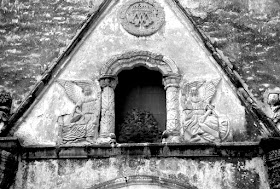In a previous post we remarked on the pervasive images of death throughout this former Franciscan monastery. Here we focus on the north doorway of the cathedral, the main ceremonial entry to the church in colonial times, as it remains today.
This lofty, 16th century entry retains its medieval appearance and ambience. Unadorned columns capped by Gothic capitals flank the plain arched doorway.
Above the doorway, a lofty, rectangular alfiz encloses a steep, triangular pediment, which in turn frames a trilobed, mudéjar niche with foliated jambs. Archaic reliefs of hovering angels, sculpted tequitqui style with spread wings and windblown draperies, lean in from either side.
Overhead, a crowned monogram of the Virgin Mary, dated 1552 and emblazoned within a wreath, was no doubt intended to remind the faithful of the dedication of the church to the Assumption of the Virgin, as well as the historic significance of the north doorway, or portiuncula, of the church of Santa Maria degli Angeli in Assisi, rebuilt by St. Francis himself.
Finally, a foliated Calvary cross with a crown of thorns around the neck stands over the pediment, atop a chilling skull and crossbones set against the black rocks of Golgotha—an arresting memento mori to impress the entering worshipper or pilgrim.
text and images © 2018 Richard D. Perry






No comments:
Post a Comment